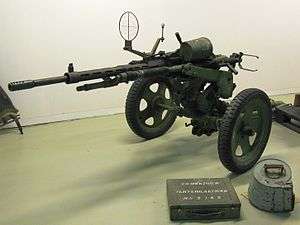Madsen 20 mm cannon
The 20 mm AA Machine Cannon M/38 was a 20 mm rapid fire autocannon produced by the Danish company Dansk Industri Syndikat (DISA). The gun, which could be adapted to several tactical uses, was a primary weapon of the military of Denmark. It was also exported to numerous countries around the world because of its versatility. The cannon was built at the DISA works in Herlev near Copenhagen. The company supplied several different types of mountings with the weapon which allowed it to be employed in a variety roles such as aerial defences, anti-tank warfare or on naval ships.
| Madsen 20 mm cannon | |
|---|---|
 Madsen 20 mm cannon | |
| Type | Autocannon |
| Place of origin | Denmark |
| Service history | |
| Used by | See Users |
| Wars | Second Sino-Japanese War World War II Winter War Continuation War Chinese Civil War |
| Specifications | |
| Mass | 55 kilograms (121 lb) |
| Length | 2.5 m (8 ft 2 in) |
| Barrel length | 1.2 m (3 ft 11 in) L/60[1] |
| Cartridge | 20 x 120 mm |
| Cartridge weight | .29 kg (10 oz) AP .32 kg (11 oz) HE |
| Caliber | 20 mm |
| Barrels | air-cooled |
| Action | recoil-operated |
| Rate of fire | 400 rpm (cyclic) 250 rpm (practical) |
| Muzzle velocity | 900 m/s (3,000 ft/s) |
| Effective firing range | 500 m (1,600 ft) |
| Maximum firing range | 2,123 m (6,965 ft) |
| Feed system | 10, 15 or 60 round magazine[1] |
| 20x120 mm Madsen | |
|---|---|
| Type | Autocannon |
| Place of origin | Denmark |
| Production history | |
| Manufacturer | Kynoch |
| Specifications | |
| Rim diameter | 28.9mm[2] |
Design
The 20 mm Madsen Cannon was originally built by Colonel V. H. O. Madsen of the Royal Danish Army. A version with a necked-out 23 mm round was also produced for the cannon known as the 23 mm Madsen.
Combat
Several 20 mm machine cannons of the Danish Army were responsible for knocking out eleven armoured cars and two Panzer I's during the German invasion on April 9, 1940.[3]
A special variant, the Madsen F5 was designed as an anti-tank gun. It proved very effective against the Japanese tanks until the end of the Second Sino-Japanese War. It was a fully automatic weapon, with two small wheels and a 15-round magazine. At 100 m, it was able to pierce 42 mm of armor, and 32 mm at 500 m.[4] This model was reversed engineered by the Chinese 21st arsenal of Nanjing but only five were produced in 1944.[5]
Mounts
Types
The four standard mountings produced by DISA, although they also used a number of locally designed mounts, were:[6]
- Light Field Mount - Primary anti tank mount, could be folded up and stowed on a motorcycle sidecar
- Universal Mount - Dual purpose mount, fitted with wheels it could be towed by its crew.
- Mobile Anti-Aircraft Mount - Dedicated AA mount.
- Tri-axial Mount - Light weight mount intended for fortifications and naval use.
Self-propelled
- Landsverk L-60 - Light tanks made in Sweden by AB Landsverk and employed by:

- Landsverk Lynx - Armored cars made in Sweden by AB Landsverk and employed by:

- Landsverk L-180 - Armored Cars made in Sweden by AB Landsverk and employed by:
Users
References
- Chamberlain, Peter (1975). Anti-aircraft guns. Gander, Terry. New York: Arco Pub. Co. p. 6. ISBN 0668038187. OCLC 2000222.
- An introduction to collecting 20 mm cannon cartridges Archived 2012-10-25 at the Wayback Machine
- Gert, Lausen. "The German occupation of Denmark". Archived from the original on 2013-10-15.
- Ness, Leland; Shih, Bin (July 2016). Kangzhan: Guide to Chinese Ground Forces 1937–45. Helion & Company. p. 321. ISBN 9781910294420.CS1 maint: ref=harv (link)
- Ness & Shih 2016, p. 328.
- Jessen, Halvor (1946). Automatic Standard Arms of Modern Warfare XI. Compagnie Madsen.
External links
| Wikimedia Commons has media related to 20 mm Madsen. |